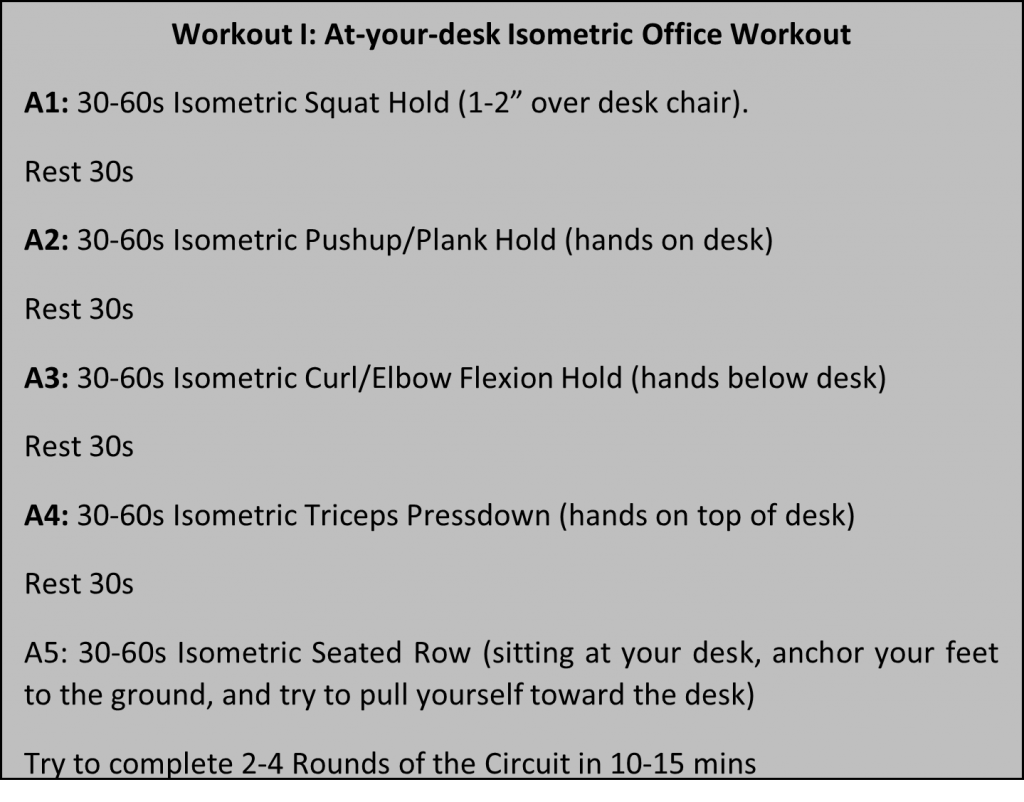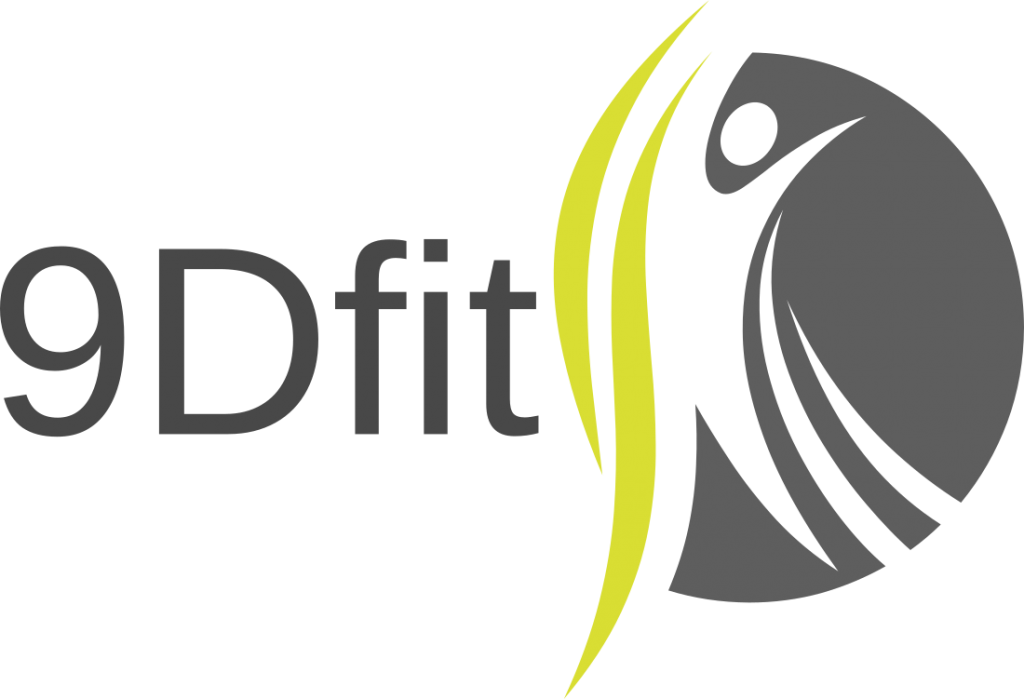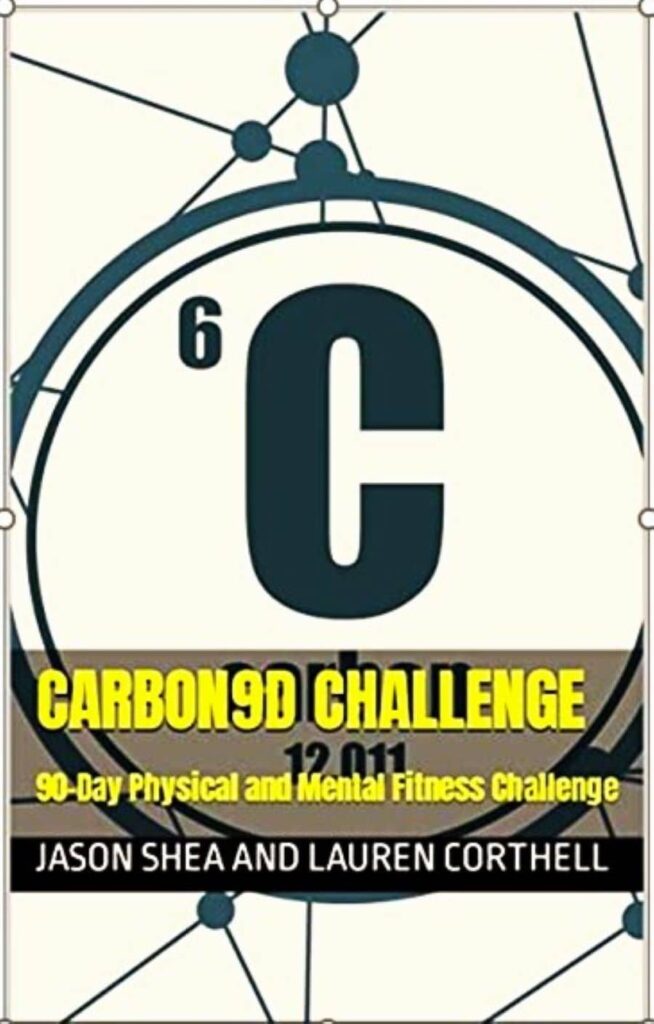By Jason Shea, M.S., PICP IV, CSCS
How can I exercise while working full time?
It’s 5:30 and you’ve just gotten home from a long day of work. Strategizing how to get the kids from point A to point B for activities, making sure homework is done, getting dinner ready, checking emails, etc. Before you know it you are cleaning up dishes, throwing in the days laundry and packing school bags for the next day. You barely have the energy to prep for the next day, never mind sitting down and staring aimlessly at the latest Netflix series playing on the TV.
With this constant weekly hamster wheel, there just doesn’t seem to be enough time to to do anything else. It is a struggle to figure out how to fit in exercise when working full time, never mind get back to that “shape” you were in just a couple years ago before you had kids, started the new job, etc.
What does the typical work day look like for the average 9-5er?
According to the Bureau of Labor Statistics the average American full time employee works 8.5 hours per day. National polling has found to be as high as 9.4 hours per day or 47 hour per week. On top of the hours worked, a study out of Harvard found that we spend an average of 100 minutes per day driving/commuting.
When we throw an average of 7 hours of sleep into the mix and nearly 3 hours of TV/internet, the daily schedule of the average full-time employee looks like this:

Or per year (minus weekends)….

Did you know that a 2013 report found that 76% of employees felt tired most days during the workweek (27)? They also found that 15% actually dozed off at work at least once during the week (27). Is it safe to say that people working full-time are tired?
What did that poster with the elephant standing on the ball say…”Balance is the key to life?”
How can I fit exercise into a busy day?
It can be a challenge to figure out how to fit exercise into a busy schedule. Never mind crafting a busy schedule workout plan that we can stick to. If motivation, adherence, and energy levels were not low, and procrastination levels high, there would not be a need for 75K plus books on diet, weight loss, etc. on Amazon.
When it comes to long term health, learning how to workout with a 8-5 job (and staying committed to it) can pay huge dividends. Did you know that a forty study found that men who had better blood pressure, LDL, cholesterol, blood glucose, BMI, and handgrip strength in their 40’s and 50’s had a better chance of living to 85 and beyond (30)?
What is the best time of day to work out for busy professionals? (Excerpts from Lifestyle Hacks and Workouts for Working People).
A 2019 study out of the School of Human Movement and Nutrition Sciences in Queensland (Booker) found that people who worked out in the morning completed 94% of their workouts over a 12-week period. The same study found that people who worked out in the evenings completed 87% of their workouts over that same period (1). Both AM and PM groups had similar rates of workout enjoyment, while the AM group had a slightly higher rate of time spent in vigorous intensity (3).
So, which is better?
What about lunchtime workouts? How about training at home vs the gym? Does eating play a role in workout times? Sleep? Stress?
Working out Before Work
Common online questions surrounding morning workouts include:
- Is it OK to workout before work?
- Is it good to exercise before work?
- Does working out before work give you energy?
- Why is it better to exercise in the morning?
- Exercise in the morning to lose weight?
- Does morning exercise benefit your brain?
- is it better to exercise in the morning?
Let’s look at 7 Benefits of Working Out Before Work
- Increased energy levels: In a 2008 study found that 6 weeks of 20 minutes per day of moderate intensity workouts led to a 32% increase in vigor. The subjects that did not workout saw their vigor levels drop by 20% (23).
- Increased 24-hour calorie burning: There is a phenomenon called EPOC that occurs after intense workouts. It stands for Exercise Post Oxygen Consumption. It is the amount of oxygen our body burns post exercise. Workouts increase EPOC, with harder workouts increasing it more. A 2015 study had a group of subjects work out at different times: morning, noon, and evening. The morning workout led to the greatest caloric expenditure and fat burned over the 24 hours that followed (15). Another study, this one from 2017, found morning workouts increased fat burning throughout the day 30% more than no morning workout (16).
- You’ll eat better: Researchers found that working out for 30 minutes three times a week led to better eating habits afterward (17). If you work out first thing in the morning, you may find yourself eating better throughout the day.
- Better attention and focus: In his 2013 book, Spark, Harvard researcher Dr. John Ratey introduced the mainstream to BDNF (short for Brain-Derived Neurotropic Factor). BDNF acts like fertilizer for your brain. It increases with exercise and has been linked to improved memory, focus, attention, and overall cognitive health. A collaborative study out of the British Journal of Sports Medicine found that a moderate intensity workout first thing in the morning increased BDNF levels. This led to better performance in cognitive tests on attention, working memory, and executive function (29).
- You will sleep better: Working out in the morning provides a one-two punch for improving sleep. One, it may be a struggle to keep your eyes open once your head hits the pillow, and two, working out in the morning leads to longer, deeper sleep. A 2014 study looked at the effects of working out at 7am, 1pm, and 7pm on blood pressure and sleep quality. The researchers found that the 7am workouts led to lower blood pressure at night (more relaxed) and better overall quality of sleep (6).
- Optimal Cortisol levels for working out: Your cortisol levels rise in the morning to wake you up and drop throughout the day, hitting a low when it is time to fall asleep. A 2014 study on competitive cyclists found insulin, cortisol, and testosterone levels were all higher at baseline in the morning versus evening. This creates an optimal environment for working out (7).
- Starting the day off with a win: In his book “Make your Bed” Admiral William H. McRaven talks about the importance of taking pride in making your bed first thing in the morning. It starts the day off with a completed task. In working with guys that have gone through the pipeline for SWCC and BUDS, they have told me that some days, making your bed might be the only win you get for the day.

By getting your body up and moving, blood flowing, neurotransmitters and hormones going, and brain function up and running, morning workouts offer many benefits.
If you find yourself struggling to get going in the early morning hours, here are a few tips:
- Acetyl-l-carnitine: Carnitine shuttles fatty acids into the mitochondria of your cells so it can be burned and used to produce energy. Carnitine is important for energy production, heart health, brain function and has been shown to:
- Increase fat burning
- Aid in boosting testosterone
- Lower inflammation by boosting levels of your body’s natural antioxidant glutathione
- Decrease lactic acid levels
- Increase mental and physical energy levels, and cognitive function
- Help mood, memory, and focus.
- Alpha GPC: A naturally occurring choline compound, Alpha GPC was tested against caffeine to determine which improved mood, cognitive function, and performance more. The alpha GPC improved serial subtraction scores and vertical jump peak power significantly more than caffeine (Parker). In a separate study, 6 days of alpha-gpc supplementation increased isometric lower body strength (1).
- Java Stim: A unique supplement that contains 225mg of caffeine and L-Tyrosine and L-Phenylalanine; both of which prevent the post caffeine consumption crash. Research has shown caffeine can:
- Improve workout intensity and power
- Increase fat burning by up to 10% in obese people and 29% in lean people
- Improve physical performance by an average of 11-12%
- Increase metabolic rate by 3-11%
- Decrease delayed onset muscle soreness
- Increase dopamine levels
- Improve memory, mood, and focus.
- Coffee with MCT Oil: All the benefits of caffeine, combined with medium chain triglycerides; fats that ramp up the body’s fat burning. Coconut oil is an example of an MCT. Another benefit to quality coffee is its natural antioxidants (polyphenols). If you are using a Keurig, Death Wish is a great tasting, organic, and strong coffee.
Working out at work
4 benefits to working out at work/lunch (Why and How can I exercise while working?)
- Mid-day stress relief break: Research has shown that 4 weeks of working out with weights not only lowers cortisol levels, but it can raise resting testosterone levels by up to 40%. Other research has shown that working out is effective at lowering anxiety levels (25).
- Increases afternoon productivity levels: A study from 2011 found that employees who devoted 2.5 hours per week to exercise during their working hours, saw an increase in productivity compared to those who did not workout (28).
- Re-energize you for the rest of the day: Just as you are starting to feel a little fatigued at the mid-day point, a workout can increase blood flow, stimulate the release hormones and neurotransmitter, and improve cognitive function and focus. Increases in vigor and drop in fatigue have been seen in chronically fatigued subjects who worked out for 20 minutes a day three days per week (23).
- Better mental health and resilience: A study from the International Journal of Workplace Health Management found that “compared to days when no exercise was undertaken during the working day, exercising improved mood and performance, leading to better concentration, work-based relationships and heightened resilience to stress (20).”
Working out after work
6 Benefits of Working Out After Work
- More power: A 2014 study out of Brazil found subjects had roughly 11% greater power output and 18% greater anaerobic power in subjects who did a 1000m cycling time trial in the evening versus the morning (7).
- You can work out longer (and harder): Research out of the Department of Kinesiology at the University of North Texas looked at the time to exhaustion, anaerobic capacity, and oxygen uptake in 20 healthy subjects doing a high intensity bike test in the morning versus evening. The evening workout time to exhaustion was roughly 20% greater than the morning workout time. The oxygen uptake and anaerobic capacity were also greater, both of which may have played a role in the ability to workout longer and harder (13).
- Greater gains in muscle?: An 11-week study found greater muscle gain (hypertrophy) in the evening workout group (11.9% vs 8.8%). Even though testosterone levels were higher in the mornings, researchers have theorized this greater muscle gain may be due to a greater testosterone response to weight training in the afternoons/evening (12).
- Optimal internal environment for working out: Your body temperature is usually highest in the afternoon. This means your core temperature is already higher, leading to better blood flow, joint mobility, flexibility, increased nerve conduction speed, and more. and preferential meteorological conditions may all contribute to diurnal variation in physical performance (12). Combined, these can lead to a decrease in injury risk and an increase in workout performance.
- Stress Relief: After a long, perhaps mentally taxing day at work, a quick 30-45 minute workout can be effective in relieving stress. A study out of the journal Frontiers in Psychology, found that just one workout at moderate intensity was effective at relieving stress and anxiety (25).

- Improved deep sleep: Working out or activity in the evening can lengthen the time you spend in deep REM sleep. A meta-analysis on 23 different studies found that working at moderate intensity in the evening led to nearly 7% more time spent in deep slow wave sleep (24).
If you do find yourself struggling to come down from an intense workout too close to bed here are a few hacks:
- Reishi Mushroom Extract: Reishi mushroom extract can have a calming effect on the body’s central stress response system, the hypothalamic pituitary adrenal axis (HPA for short). It is thought to impact the adrenals directly (31).
- Magnesium Glycinate: Magnesium that is combined with glycine, an amino acid that promotes calmness and better sleep. Magnesium glycinate has many of the benefits of magnesium including hormonal balance, decreased inflammation, stress relief, and health blood sugar levels.
- Phosphatidylserine: A naturally occurring phospholipid that makes up part of the cell membrane. It has been recommended for lowering cortisol and improving sleep. A 2015 study found that when taken with Omega-3 fatty acids for 12 weeks, phosphatidylserine lowered cortisol levels while helping to restore circadian rhythm (26).
- Ubermag Plus Px 2.0: Quite possibly one of the best magnesium products on the market. This contains 4 types of elemental magnesium (chelate form, not salt form): Magnesium Taurate, Magnesium Glycinate, Magnesium Fumarate, Magnesium Orotate. It also contains 250mg of L-Tryptophan and 5mg of Pyridoxal 5’ Phosphate. Magnesium by itself has a calming effect on the nervous system. When you combine it with Tryptophan and Pyridoxal-5-Phosphate, a cofactor in neurotransmitter production and circadian rhythm support, the calming and sleep-inducing effects are amplified.
Now that we have seen the benefits of working out at certain times of the day, let’s look at some program and workout design strategies to maximize adherence and minimize downtime interruption.
Workouts for the Busy Professional
Before we delve into home, at-work, and gym workouts, let’s talk first about a concept popularized by Russian Kettlebell Master of Sports and Author of Power to the People, Pavel Tsatsouline; Greasing the Groove.
Did you know that a 2016 study out of McMaster University in Ontario, compared the cardiometabolic effects 12 weeks/3 times per week of short interval bike sprints (SIT) vs moderate intensity continuous biking (MICT) (8). The workout protocols consisted of:
- SIT:10 Minutes Total
- 2 Minute Warm-Up
- Three 20s all-out cycle sprints
- 2 Minute rest interval between each Sprint
- 3 Minute Cooldown
- MICT: 50 Minutes Total
- 2 Minute Warm-Up
- 45 Minutes Continuous Cycling at 70% Max HR
- 3 Minute Cooldown
Return on Investment
Below is a weekly and total (3 month) time investment in minutes of each protocol:


After 12 weeks, the researchers found 10-minute Short Interval bike sprints led to better improvements in:
- Max workload (Watts): 13.17% vs 9.27% (8)
- Insulin Sensitivity: 54.06% vs 34.0% (8)
- Glucose rate of disappearance (%/min): 14.29% vs 5% (8)
- Fasting Plasma Insulin (uIU/mL): 17.89% vs 16.83% (8)
- Homa-IR (Insulin Resistance): 9.52% vs 4.17% (8)
- Skeletal Muscle Mitochondrial Content: 48% vs 27% (8)
Just for clarification purposes? The same or better results despite 5X less the time commitment? That sounds like a pretty good investment.
The researchers concluded “we report that a SIT protocol involving 3 minutes of intense intermittent exercise per week, within a total time commitment of 30 minutes, is as effective as 150 minutes per week of moderate-intensity continuous training for increasing insulin sensitivity, cardiorespiratory fitness and skeletal muscle mitochondrial content in previously inactive men (8).”
According to a Harvard Men’s Health Watch article titled How much exercise do you need?, “for health, doctors should “prescribe” at lease 30 minutes of moderate exercise or 15 minutes of intense exercise a day (11).” A 2015 meta-analysis study out of the British Journal of Sports Medicine that 15 minutes a day of moderate-to-vigorous exercise led to a 22% decrease in mortality rates (14). A systematic umbrella review of the scientific literature in 2019 had similar results (18).
Three 20s sprint intervals 3 times per week. 15 minutes of moderate-to-vigorous exercise a day. In the modern, work 8-9hrs per day, drive 1-2hrs per day, sleep 7hrs per day, watch TV 3hrs per day schedule, finding 10 minutes here or 15 minutes there for a workout seems doable. Perhaps Harland William’s hitchhiker character in Something About Mary was on to something when he told Ben Stiller’s character about his “7-minute abs” idea.
Greasing the Groove
In his book Power to the People, Tsatsouline talked about increasing strength by building neurological pathways/connections through repetition and practice. Similar to practicing a new skill, such as a golf or tennis swing, the more exposure the muscles and nervous system get to that movement, the more the neurological connections are grooved.
Think of a shaking the hand of a mechanic or mason. Oftentimes they have grips of steel. Everyday, for years on end, due to the nature of their work, they have “greased the groove” of the muscles of their forearms. When the great U.S. Olympic wrestling legend, Dan Gable, wanted to get better at chin-ups, he hung a bar at every doorway in his house. Every time he walked through the door, he made himself do 10 chin-ups.
According to a 1987 Chicago Tribune article, when basketball great, Charles Barkley wanted to become more explosive and athletic, one of the things he did was jump over a fence nearly every day. ‘We had a chain-link fence about 5 feet high,” said Barkley`s grandmother, Johnnie Edwards, ”and he`d jump from one side to the other–I mean flat-footed. And he`d do it over and over again, maybe 15 or 20 times. Then he`d rest and do it again. He did that just about every day. I think that jumping had a lot to do with him growing that summer (4)’.
Did you know that in his youth, all-time strikeout and no-hitter champion, Nolan Ryan, had to help his Dad deliver newspapers nearly every morning between the hours of 1-4am? According to an autobiography on Ryan, he was said to have delivered 1500 papers per day, rolling them into tight cylinders and throwing them far onto the lawns of their customers.
In his excellent, eye-opening book, Squat Everyday, author Matt Perryman introduces the readers to how he fixed his ailing knees: by squatting every day. Though he lifted heavy most days, he, in essence, “greased the groove” by never training to exhaustion.
Multiple short workouts per day?
In 2007, researchers compared the effects of one-a-day and two-a-day training on nationally ranked competitive weightlifters. After 3 weeks, the two-a-day training group had twice the gain in EMG muscle activation, as well as significantly more favorable increase in testosterone and testosterone/cortisol ratios (10). A separate study on 2-a-day training found significant increases in testosterone during the second workout of the day (9).
A recent study on something called Post-Activation Potentiation (PAP) found that Hockey players who trained hard 6 hours prior to performance testing, had better performances in broad jump and on-ice 40m conditioning sprint testing (19). For more on this training method check out Explosive Athlete: Jump Higher, Run Faster… Perform Better!
Bodyweight and Weight training for busy professionals
Let’s look at a few examples:
- Quick and effective home workout for busy professionals.
Workout 1:

Workout 2:
Fountain of Youth Bodyweight Circuit
Objective: To complete 4 rounds of circuit with complete range of motion per exercise according to guidelines.
| Beginner | Full Circuit: 4 rounds of 30 Butt to Heel Squats 30 Lockout Pushups 30 Full Sit-ups 10 Full Pull-ups | <20 Minutes |
| Intermediate | Full Circuit: “Same as above” | < 16 Minutes |
| Advanced | Full Circuit: 4 rounds of “Same as above” | <12 Minutes |
Benefits
- Improved Body Composition: Greater lactic acid accumulation is associated with an increase in the production of endogenous growth hormone. Research studies have shown that growth hormone is associated with a trainee’s ability to lose body fat. A study out of the Journal of Clinical Endocrinology and Metabolism found that those subjects who had clinically low levels of growth hormone had higher body fat. A 2011 study found that GH deficient subjects who received growth hormone replacement therapy over a six month period had significant increases in lean body mass and decreases in fat mass when compared to their placebo counterparts. The combination of circuiting higher rep ranges and little to no rest will spike lactate potentially leading to a positive endogenous growth hormone response!
- Peripheral Heart Action: The body is trying to shunt oxygenated blood from one body part to another while trying to remove waste by-products. During the squats, the blood needs to get to the legs, then to the stabilizers and prime movers during pushups, then to the abdomen and hip flexors during sit ups, and lastly to the stabilizers and prime movers during pull-ups. This shunting can lead to an increased demand on the cardiovascular system, in turn allowing for improvements in cardiovascular health and muscular endurance. Especially great for endurance athletes who need a break from the grind of long, slow, conventional endurance training.
- Improved Structural Balance: Over time complete range of motion training can aid in lengthening of muscle fibers and surrounding fascial tissue. Including antagonistic muscle group training in a workout can improve the length tension ratio between the muscles on opposite sides of a joint.
- Improved Technique in Body Weight Exercises: This workout is an opportunity to work on technique in full range of motion body squats, pushups, sit-ups, and pull-ups.
- Active Recovery: Due to the blood flow demands and growth hormone response, this bodyweight circuit workout can be viewed as a form of active recovery at the end of a weight training workout or on off-days from weight training.
Guidelines
| Exercise | Repetitions | Rest Interval | Technique |
| A1: Butt to Heel (mobility dependent) Body Squats | 30 | No Rest | Heel to butt with torso remaining as vertical as possible. Hindu squats are permitted |
| A2: Full Range of Motion with 1second lockout Pushups | 30 | No Rest | Humerus 45degrees or less from sides. Chest touches or upper arms parallel to floor at bottom. Arms locked out for 1 second pause at top. |
| A3: Full Range of Motion Sit-Ups | 30 | No Rest | Feet can be anchored. Shoulder blades touch ground at the bottom. Torso vertical at top. Arms can be crossed in front or can swing overhead. |
| A4: Full Range of Motion with 1second pause at bottom Pull-ups | 10 | No Rest | Arms fully extended for 1s at bottom. Chin above bar at top. No kip-ups!! |
- Cannot move on to the next exercise until all repetitions of previous exercise have been completed.
- Complete 4 rounds with full range of motion technique in as little time as possible.
Programming
8 Week Progression
| Week I | Try to complete 1 round at the end of a workout or on off day. On a separate day try same thing again. |
| Week 2 | Try to complete 1 round at the end of a workout or on off day. Rest if you need, then try to complete a second round. On a separate day try same thing again. |
| Week 3 | Try to complete 1 round at the end of a workout or on off day. Rest if you need, then try to complete a second round. Try this on two other days during the week. |
| Week 4 | Try to complete 2 rounds in a row with no rest. Perform on one or two other days during the week. |
| Week 5 | Try to complete 2 rounds in a row with no rest. Rest as long as you need, then try to complete one more round. Try this one or two other days during the week. |
| Week 6 | Try to complete 3 rounds in a row with no rest. Try this one or two other days during the week. |
| Week 7 | Try to complete 3 rounds in a row with no rest. Rest as long as you need, then try to complete one more round. Try this one or two other days during the week. |
| Week 8 | Complete 4 rounds with no rest in as little time as possible! Good luck. |
- Quick and effective at-work Office workout

***For more Office Workout ideas, including posture work, Egoscue, ELDOA, and more, pick up a copy of Lifestyle Hacks and Workouts for Working People.
- Quick and effective gym workouts for busy professionals.



Stay tuned for nutrition/supplement, longevity, and stress management strategies, APPs, equipment, and accountability methods in Part II of Workouts for Working People – The Ultimate Guide. For even more info, pick up a copy of the book Lifestyle Hacks and Workouts for Working People on Amazon.com today!

References
- Bellar D et al. The effect of 6 days of alpha glycerylphosphorylcholine on isometric strength. Journal of the International Society of Sports Nutrition. 12(4); 2015.
- Bibeau W, et al. Effects of acute resistance training of different intensities and rest periods on anxiety and affect. Journal of Strength and Conditioning Research. 24(8); Pp 2184-2191. 2010.
- Booker P, et al. The feasibility and acceptability of morning versus evening exercise for overweight and obese adults: A randomized controlled trial. Contemporary Clinical Trials Communications. 14; 100320. 2019
- Bruton M. CHARLES BARKLEY: A MAN DRIVEN. Chicago Tribune. Feb 15, 1987.
- Calle et al. Overweight, obesity, and mortality from cancer in a prospectively studies cohort of US adults. New England Journal of Medicine. 348(17); Pp 1625-1638. 2003.
- Fairbrother K, et al. Effects of exercise timing on sleep architecture and nocturnal blood pressure in prehypertensives. Vascular Health and Risk Management.10: Pp 691–698. 2014.
- Fernandes A, et al. Effect of Time of Day on Performance, Hormonal and Metabolic Response during a 1000-M Cycling Time Trial.PLoS One. 9(10): e109954. 2014.
- Gillen J, et al. Twelve Weeks of Sprint Interval Training Improves Indices of Cardiometabolic Health Similar to Traditional Endurance Training despite a Five-Fold Lower Exercise Volume and Time Commitment. PLoS One. 2016. https://doi.org/10.1371/journal.pone.0154075.
- Hakkinen K, et al. Neuromuscular and hormonal responses in elite athletes to two successive strength training sessions in one day. European Journal of Applied Physiology and Occupational Physiology. 57(2); Pp 133-139. 1988
- Hartmann H, et al. Comparisons between twice-daily and once-daily training sessions in male weightlifters. International Journal of Sports Physiology and Performance. 2(2); Pp 159-169. 2007.
- Harvard Men’s Health Watch. How Much exercise do you need? Harvard Medical School Health Publishing. 2009.
- Hayes L, et al. Interactions of cortisol, testosterone, and resistance training: influence of circadian rhythms. Chronobiology International. 27(4); Pp 675-705. 2010.
- Hill DW. Morning-evening differences in response to exhaustive severe-intensity exercise. Applied Physiology, Nutrition, and Metabolism. 39(2): Pp 248-54. 2014.
- Hupin D, et al. Even a low-dose of moderate-to-vigorous physical activity reduces mortality by 22% in adults aged ≥60 years: a systematic review and meta-analysis. British Journal of Sports Medicine. 49(19); Pp 1262-1267. 2015.
- Iwayama K, et al. Exercise Increases 24-h Fat Oxidation Only When It Is Performed Before Breakfast. EBioMedicine. 2(12); Pp 2003-2009. 2015.
- Iwayama K, et al. Exercise before breakfast increases 24-h fat oxidation in female subjects. PLoS One. 12(7); e0180472. 2017.
- Jaehyun Joo. The influence of 15-week exercise training on dietary patterns among young adults. International Journal of Obesity. 43:1681–1690. 2019.
- Kraus W, et al. Physical activity, all-cause and cardiovascular mortality, and cardiovascular disease. Medicine and Science in Sports and Exercise. 51(6); Pp 1270-1281. 2019.
- Legrange et al. Contrast training generates post-activation potentiation and improves repeated sprint ability in Elite Ice Hockey players. International Journal of Exercise Science. 13(6); Pp 183-196. 2020.
- McKenna J, et al. Exercising at work and self-reported work performance. International Journal of Workplace Health Management. 1(3); Pp 176-197. 2008.
- Moore et al. Leisure time physical activity of moderate to vigorous intensity and mortality: a large pooled cohort analysis. PLoS Medicine. 9(11). 2012.
- Parker A, et al. The effects of alpha-glycerylphosphorylcholine, caffeine or placebo on markers of mood, cognitive function, power, speed, and agility. Journal of the International Society of Sports Nutrition. 12(41); Pp 41. 2015
- Puetz TW, et al. A randomized controlled trial of the effect of aerobic exercise training on feelings of energy and fatigue in sedentary young adults with persistent fatigue. Journal of Psychotherapy and Psychosomatics. 77(3); Pp 167-174. 2008.
- Spengler C, et al. Effects of Evening Exercise on Sleep in Healthy Participants: A Systematic Review and Meta-Analysis. Sports Medicine. 49; Pp 269–287. 2019.
- Strickland and Smith. The anxiolytic effects of resistance exercise. Frontiers in Psychology. 5; Pp 753. 2014.
- Tremblay M, et al. Physiological and health implications of a sedentary lifestyle. Applied Physiology, Nutrition, and Metabolism. 35(6); Pp 725-740. 2010.
- Turgiss J, et al. Asleep on the Job. Virgin Pulse/vieLife.
- Von Thiele et al. Employee self-rated productivity and objective organizational production levels: effects of worksite health interventions involving reduced work hours and physical exercise. Journal of Occupational and Environmental Medicine. 53(8): Pp 838-44. 2011.
- Wheeler M, et al. Distinct effects of acute exercise and breaks in sitting on working memory and executive function in older adults: a three-arm, randomised cross-over trial to evaluate the effects of exercise with and without breaks in sitting on cognition. British Journal of Sports Medicine. 2019.
- Wilcox et al. Midlife risk factors and healthy survival in men. JAMA. 296. Pp 2343-2350. 2006.
- Winston D, S Maimes. Adaptogens: Herbs for Strength, Stamina, and Stress Relief. Healing Arts Press. 2007.


